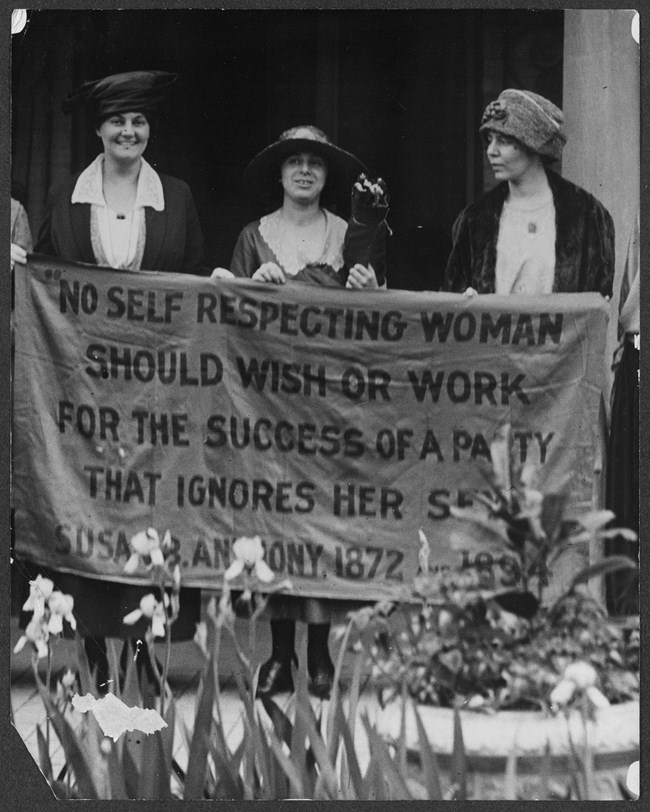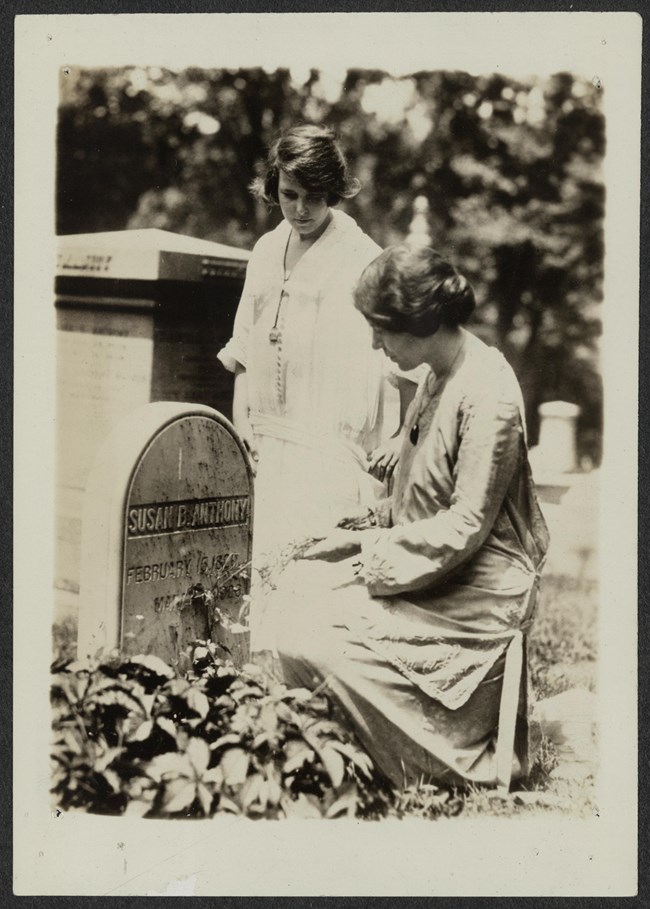Part of a series of articles titled Curiosity Kit: Dr. Alice Paul .
Next: Places of Dr. Alice Paul
Article

This Curiosity Kit Educational Resource was created by Katie McCarthy, a NCPE intern with the Cultural Resources Office of Interpretation and Education.
Alice Paul was born in 1885 on her family’s farm in Mount Laurel, New Jersey. As a young adult, Paul attended Swarthmore College, worked at a settlement house in New York City, and attended graduate school at the University of Pennsylvania and in Birmingham, England. While in England, Paul became involved in the British women’s suffrage movement. After returning to the United States, Paul became increasingly involved in the women’s suffrage movement here.
While she was originally a member and leader in the National American Woman Suffrage Association (NAWSA), her more confrontational approach led her to create her own suffrage organization. Paul worked with fellow suffragist Lucy Burns to found the Congressional Union for Woman Suffrage, which became the National Woman’s Party (NWP). After the 19th Amendment was passed, Paul continued to advocate for women’s rights. In 1923, Paul proposed a constitutional amendment called the Equal Rights Amendment. It was introduced in every Congressional session until it was passed in 1972 but was not ratified by the necessary number of states. You can learn more about Alice Paul and her life-long campaign for women’s rights by exploring the Places Of Dr. Alice Paul and this article focused on her.
Learn about the women’s suffrage campaign through Dr. Alice Paul’s life and work.
Identify art and music associated with the suffrage movement.
Explore Constitutional Amendments like the 19th Amendment and the Equal Rights Amendment.
What strategies do people use to amplify their message and create change? What strategies can you use?

In 1913, Alice Paul asked Nina Allender to draw cartoons supporting the women’s suffrage campaign. These cartoons helped to shape the public’s perception of what a suffragist looked like. You can see some of Allender’s cartoons here and learn more about suffrage and anti-suffrage cartoons here. Allender’s cartoons perpetuated an image of the ideal suffragist as young, white, and wealthy. Today, we know that this is not a true picture of the suffrage movement: working-class women and women of color also supported the suffrage movement and contributed greatly to it.
Take some time to explore Allender’s cartoons and some of the suffragist profiles. After you do so, use your new knowledge to draw one or more pro-suffrage cartoons. Your cartoon(s) should represent the variety of people who supported the suffrage movement, and their different motivations.
Alongside cartoons and banners, music was an important part of sharing the message of suffrage. Pro-suffrage songs were meant to rally and inspire, bringing listeners to the cause. You can find women’s suffrage sheet music at the Library of Congress. Some songs were later recorded, and you can listen to those online at the Smithsonian. (Note: There are options to pay and download the songs, but you can listen to them for free on the Folkways website by hovering over the track listing and clicking play.)
Using suffrage music as inspiration, it’s time to create your own collection of music! What is a cause that you feel passionate about? How can you capture it with music? As you build a playlist that represents, celebrates, and advocates for this cause, consider the following questions:
Can you identify any artists that also feel passionate about this cause?
Are there any songs that advocates of this cause already use?
What styles or genres might represent this cause well?
What songs share the feeling or message your trying to convey?
Have there been any songs written for this cause already?
As an alternate project, instead of coming up with a playlist, write your own song! As you do so, think about what kind of message you’d like to share and what words and tunes will support that best.

When the Constitution was written, it was ratified with ten initial amendments called the Bill of Rights. Amendments are changes or additions to the original laws in the Constitution. Since the Bill of Rights, seventeen additional amendments have been added to the Constitution. You can find a list of amendments here. Constitutional Amendments are important because they affect everyone in the United States – no matter where you live or who you are. Alice Paul supported two different amendments during her lifetime: the 19th amendment, and the Equal Rights Amendment. Although the 19th Amendment was ratified, the Equal Rights Amendment was not. The 19th Amendment says that the right to vote can't be denied based on sex. However, it doesn't address other ways that women (and men) have been kept from voting. The purpose of the Equal Rights amendment was to guarantee legal gender equality between women and men.
You can find more information about the Constitutional amendment process at Teaching with Historic Places.
Choose one of the twenty-seven amendments to research. You may also choose to research a failed Constitutional Amendment; one that was proposed by not passed by Congress or ratified by the states. The Equal Rights Amendment is one example of a failed amendment. As you do, consider the following questions:
What year was this amendment first proposed to Congress? What year was it ratified?
Who proposed the amendment?
How did this amendment change existing laws?
Who supported this amendment? Why do you think they supported it?
Who opposed this amendment? Why do you think they opposed it?
How does this Amendment affect people in the United States? How does it affect your community specifically?
Part of a series of articles titled Curiosity Kit: Dr. Alice Paul .
Next: Places of Dr. Alice Paul
Last updated: April 22, 2021